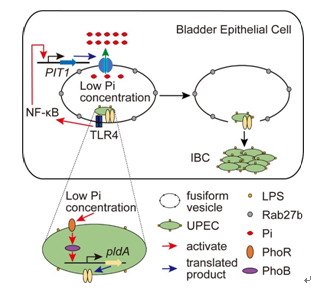A recent study from a Nankai research team revealsthe molecular mechanism of a key vesicle escape step in the pathogenesis of UPEC, and the team finds that silence of host phosphate transporter PIT1 using Accell siRNA can effectively inhibit UPEC infection. This discovery provides new ideas for treating urinary tract infection (UTI). The paper describing aforesaid work is published in international academic journal Cell Reports.

Schematic diagram of the mechanism for UropathogenicEscherichia coli (UPEC)
escape from fusiform vesicles
Using cell culture, mouse models, Nankai research team discovered that UPECinitiates its escape by sensing the host immune responses and expressing an outer membrane phospholipasePldA to disrupt host fusiform vesicle membrane.UPECinfection upregulates the expression of phosphate transporter PIT1 in host cells through the TLR4/NF-κBsignaling pathway. Located on fusiform vesicle membrane, PIT1 transports phosphate into the cytosol. Upregulation of PIT1 expression reduces phosphate concentration in fusiform vesicles. PldA of UPECdisrupts vesicle membrane and facilitatesbacterial escape from fusiform vesicles into the cytosolthrough two-component system PhoBR in responding to the low-concentration of inorganic phosphorus environment in fusiform vesicles. In vivosilenceof PIT1 blocksUPEC escape from fusiform vesicles in bladder epithelial cells, and inhibits formation of intracellular bacterial communities in mouse bladder cells, thus protects mice from UPEC infection.
“Our study reveals a molecular mechanism ofUPEC escape from fusiform vesicles,a key step in bacterial pathogenesis, mediated by host PIT1, and in vivosilence of PIT1 in mouse bladdersusing Accell siRNA reduces UPEC colonization in mouse bladders, and inhibits urinary tract infection”, said Feng Lu, “Accell siRNA is a well-established RNA interference therapy that can be applied to human, so this work both identifies a new drug target and demonstrates the feasibility of using a more established technology to achieve the treatment.”
These findings on the pathogenic mechanisms of UPEC provide new ways to treat UTI, a chronic disease.Scientists from Baylor College of Medicine and Stanford University published a preview article in Cell Reports and stated that this discovery has important theoretical innovation and application value, and in the future, UTI can be treated and preventedby developing small-molecule drugs that target this interaction mechanism between pathogen and host.
Pang Yu (a post-doctoral fellow ofNankai University), Cheng Zhihui (an associate professorat the College of Life Sciences, Nankai University) and Zhang Si (a doctoral studentat TEDA Institute of Biological Sciences and Biotechnology, Nankai University) are the first authors of the paper.Professor Feng Lu and Wang Lei (both atTEDA Institute of Biological Sciences and Biotechnology, Nankai University) are co-corresponding authors of this paper, and Zhu Siwei (a professor at the Institute of Translational Medicine, People’s Hospital of Nankai University) is co-author of the paper. This research is funded by National Key Programs for Infectious Diseases of China, National Natural Science Foundation of China and National Key R&D Program of China.
Paper link: https://www.cell.com/cell-reports/fulltext/S2211-1247(22)00456-9
Click here to see the news published on 2 June, 2022 by Nankai University:
https://en.nankai.edu.cn/2022/0605/c22795a456331/page.htm

